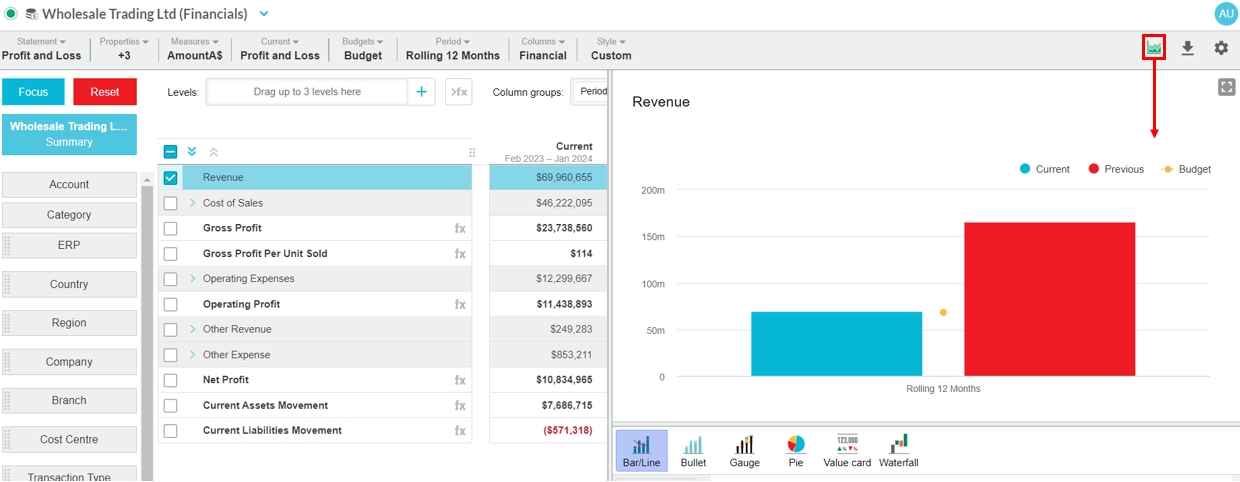View financial information in a chart
Visually explore and interact with your financial information in a chart format.
The chart builder tool, available in several modules, allows you to visually explore and interact with your data in dynamic charts.
Charts are available in all financial statements except for the Trial Balance and they work well alongside the levels and column groups features. Charts are particularly useful when the statement grid has a lot of columns and you are only interested in one row or a few rows. Rather than scrolling across multiple columns, you can visualize the row(s) instead.
Watch the videos at the bottom of this page for some demonstrations.
Create a chart
Click the green Chart button in the toolbar. The chart displays data for the selected row(s) in the grid. If you didn't have any rows selected, the first one is selected for you by default.

Configure the chart
Switch between different types of charts and configure how the data displays in each one. As you try out the different options, the chart updates accordingly. This interaction helps you find the chart type and configuration combination that best meets your needs. You can change the chart type, the data and text that displays in the chart, and the layout of the chart's contents.
Type
Click the chart buttons to switch to a different type of chart, such as Bar/Line, Bullet, Gauge, Pie (Donut), Value card, and Waterfall.
Data
The Data tab is open by default and the available options depend on the selected chart type.
Text
On the Text tab, you can edit the default title. You can also add a description of the chart, which displays as a subtitle. You can use this area to add commentary, for example “in line with prior year”.
Layout
On the Layout tab, you can:
Switch between a vertical (default) or horizontal layout of the bars in the chart.
Allow non-zero scale in the chart. When selected, this setting takes off the zero scale, to highlight the differences or emphasize trends. Not available in the Waterfall chart.
Change the location of the chart legend. By default, it displays in the top right corner but you can move this to the right of the chart or remove it altogether.
View the chart in full-screen mode
You might want to view a chart in a larger scale if you are using it in a presentation, so the audience can see the data more clearly.
Click the Full screen button on the top right of the chart. To exit out of full-screen mode, click the Close button or press the Esc key.
Interact with the grid and chart
As the chart builder sits to the right of the grid, you can view the data in two formats at the same time and interact with them simultaneously. For example, you can take the following actions:
Select one or more rows in the grid and the chart will update accordingly. The chart’s Data tab gives you options for dealing with multiple rows.
Scroll across the grid to view the data on the far right whilst keeping the chart in view. If you want a better view of the grid and a minimal view of the chart panel or vice versa, click and drag the divider to the left or right as required.
Click an item in the chart legend to remove the corresponding data from the chart, then click the legend item again to display it in the chart. For example, if your chart displays the current, previous, and budget data streams, you might want to remove the previous stream, so you can compare the current and budget more easily.
Change your view of the grid and watch the chart update accordingly. Your row selections are retained. For example, you might want to apply a different period or display all periods. See Change your view of a financial statement to learn about the different ways to change the layout and the contents of a statement.
Videos
Watch these other videos:
Phocas Demo: Visual storytelling (also shows sparklines)
PUG Training: Financial Statements – Advanced (jump to 18:16)
Next steps
When you're happy with your chart, you can add it to a dashboard to share key metrics with your team. See Add financial analysis to a dashboard.
To close the chart builder, either click the Close button in the top-right corner of the chart or click the Chart button in the toolbar.
Last updated


